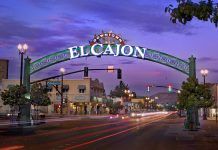
The county of San Diego held a Green Streets Clean Water program meeting on July 7, giving the public an opportunity to weigh in on nearly 1,200 miles of roads in the unincorporated area being considered for retrofits that will ultimately support cleaner water in local creeks, rivers, lakes and the ocean.
Program coordinator Rene Vidales, who moderated the public meeting, said the approach utilizes space adjacent paved roads to naturally treat runoff water before it ever ends up in the ocean.
“When it rains, runoff collects and pollutants are carried downstream. As it dries, those pollutants hurt our creeks, our reservoirs, our beaches, impacting our health and that of plants and animals,” Vidales said.
Vidales told attendees of ways to approach runoff treatment without chemicals or a power source, effectively using processes like filtration and percolation to benefit areas with water runoff, while also visually enhancing those areas.
One example he gave is a proposed Mapleview Green Streets project that occupies a stretch of road on the south side of El Capitan High School in Lakeside between Highway 67 and Ashwood Street. Currently, there are no sidewalks on that side of the school, and scrub brush has sprouted up along the side of the road, where it collects trash and pollutants.
“This is a good example of where we’re trying to reclaim some space for treatment, make a more pleasant and aesthetic look. We’re adding sidewalks that weren’t there before, improving the look of the street,” Vidales said.
That location is just one of more than 2,000 possible locations county officials are considering for teatment projects like this, and ultimately they will narrow it down to 30 ideal locations throughout unincorporated San Diego county.
Different green street design approaches are being considered, depending on what individual locations need for best outcomes.
Commonalities between varying approaches include integrating visible improvements into vehicle and pedestrian spaces, introducing green spaces that provide habitats for nesting birds, permeable pavement which “allows runoff to travel through the surface,” Dugan said, and dispersion areas that slow down water runoff.
Hydrodynamic separators housed underground are an option, as are dry wells that “can reduce some of the impacts of flooding and be placed on the surface in areas where there are other constraints,” project engineer Max Dugan said.
Catchments, areas in which runoff collects and drain to a common point “are really our building blocks,” Dugan said.
One Green Street approach he described would involve replacing concrete center medians with trees.
“Those trees would make the pedestrian experience more enjoyable and increase shade,” Dugan said, and provide a cooling effect of one to two degrees in some places.
At the same time, senior engineer Megan Otto said there are social and economic benefits associated with the approach such as reduced energy costs due to cooler temperatures, as well as increased tourism, “a more walkable neighborhood that can positively impact property values,” and lower secondary public health costs thanks to a cleaner environment.
“There are many areas that can benefit from traffic calming, areas where sidewalks can be improved,” Otto said.
What remains, she said, is for the public to give feedback on specific community needs such as enhancing green spaces, improving pedestrian safety, and other community-level concerns that could be addressed within this project.
A survey intended to gather feedback is available at www.greenstreetscleanwater.org and information from that survey will be used toward the Draft Green Streets Clean Water Plan, in which the highest priority multi-benefit green streets opportunities will be unveiled later this year.













